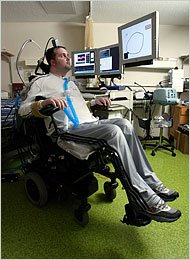Paralyzed Man Uses Thoughts to Move a Cursor
Excerpt of the news:

A paralyzed man with a small sensor implanted in his brain was able to control a computer, a television set and a robot using only his thoughts, scientists reported yesterday.Those results offer hope that in the future, people with spinal cord injuries, Lou Gehrig’s disease or other conditions that impair movement may be able to communicate or better control their world.
In a variety of experiments, the first person to receive the implant, Matthew Nagle, moved a cursor, opened e-mail, played a simple video game called Pong and drew a crude circle on the screen. He could change the channel or volume on a television set, move a robot arm somewhat, and open and close a prosthetic hand.
Although his cursor control was sometimes wobbly, the basic movements were not hard to learn.
Mr. Nagle, a former high school football star in Weymouth, Mass., was paralyzed below the shoulders after being stabbed in the neck during a melee at a beach in July 2001. He said he had not been involved in starting the brawl and did not even know what had sparked it. The man who stabbed him is now serving 10 years in prison, he said.
The sensor measures 4 millimeters by 4 millimeters — less than a fifth of an inch long and wide — and contains 100 tiny electrodes. The device was implanted in the area of Mr. Nagle's motor cortex responsible for arm movement and was connected to a pedestal that protruded from the top of his skull.
When the device was to be used, technicians plugged a cable connected to a computer into the pedestal. So Mr. Nagle was directly wired to a computer, somewhat like a character in the
"Matrix"movies.
Mr. Nagle would then imagine moving his arm to hit various targets. The implanted sensor eavesdropped on the electrical signals emitted by neurons in his motor cortex as they controlled the imaginary arm movement.
Obstacles must be overcome, though, before brain implants become practical. For one thing, the electrodes’ ability to detect brain signals begins to deteriorate after several months, for reasons not fully understood. In addition, the implant would ideally transmit signals wirelessly out of the brain, doing away with the permanent hole in the head and the accompanying risk of infection. Further, the testing involving Mr. Nagle required recalibration of the system each day, a task that took technicians about half an hour.
Still, scientists said the study was particularly important because it showed that the neurons in Mr. Nagle's motor cortex were still active years after they had last had a role to play in moving his arms.
The implant system, known as the BrainGate, is being developed by Cyberkinetics Neurotechnology Systems Inc. of Foxborough, Mass. The company is now testing the system in three other people, who remain anonymous: one with a spinal cord injury, one with Lou Gehrig's disease and one who had a brain stem stroke.
Timothy R. Surgenor, president and chief executive, said Cyberkinetics hoped to have an implant approved for marketing as early as 2008 or 2009. Dr. Donoghue, the chief developer, is co-founder and chief scientist of Cyberkinetics. Some of the paper’s other authors work at the company, while still others are from academic or medical institutions including Massachusetts General Hospital.
breaking-news,Washington Post ,BBC News ,Reuters,technology,business






















No comments:
Post a Comment